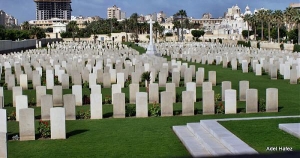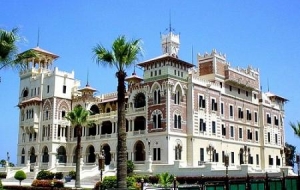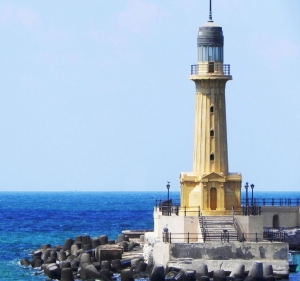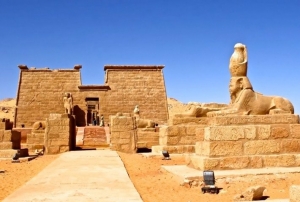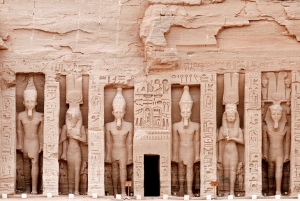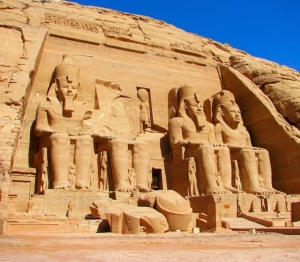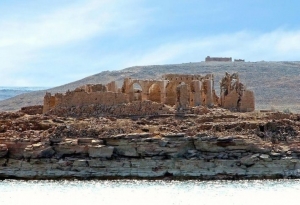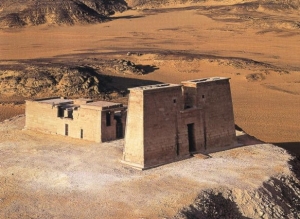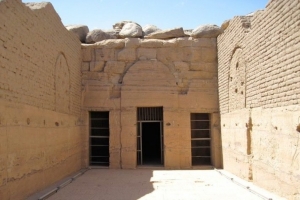+2 0122-345-3028
This email address is being protected from spambots. You need JavaScript enabled to view it.
Super User
El Chattby Cemetery
El Chattby Cemetery
This Chatby Cemetery is considered one of the mysterious treasures of Greek art, was discovered in 1904 and dates back to 300 B.C, this Cemetery is a very important monument attracts all the factors of culture and knowledge it is a truly tourist treasure specially for being in that particular location. Some of them take the shape of ancient houses while others take the structure of the Greek Temple of Olympus which shows the blend of the Pharaonic art and that of the Greco-Roman.
Alexandria Site
Alexandria site
The Pompeys pillar
It is a huge granite pillar, about 27 ms high, dates from the third century amidst the remaining relics of the Serapium. The pillar was erected in honour of the Greek emperor Diocletian.
Catacombs of Kom Al Shuqqafa:
This is the largest Roman cemetery. They consist of Three levels cut in the rock to a depth of 100 feet. Dating back to the turn of the 2nd century AD, it is a blend of Pharaonic and Roman art.
The Greeco-Roman Museum:
It tells the story of the invasion of Egypt by Alexander the Great and the building of Alexandria. It houses many collections of rare Greek and Roman relics and coins, about 40 thousand pieces, dating from the 3rd century BC till the 7th century AD. The most important and the priceless statues in the Museum is the “Tanagra” statues.
Montazah Palace:
[
It was built east of Alexandria on a high hill and overlooking the most beautiful beach of Alexandria, amid about 370 feddans of gardens and woods. The Palace comprises of a group of buildings of which the most important are being Al-Haramlek, of which the first storey has been transformed into an international casino, the second and third stories into a museum for the belongings of the former royal family.
But Al-Salamlek building has been transformed in luxurious Hotel. Another Hotel has also been built in the garden overlooking one of the most beautiful bay surrounded by green areas.
Qaitbay Citadel:
It lies in the northern tip of the eastern harbor, on the site where the ancient Pharaos of Alexandria was set up. This fort was built in the 15th century by Qaitbay, and it consists of three stories similar to medieval fortresses in Egypt. It also houses the naval museum, which revives the marine heritage of Alexandria. This museum combines models, paintings and statues portraying the development of navigation and ship building in Egypt since Pharaonic times until the present. They also represent the Egyptian sea battles throughout the ages.
Al Anfuschi Tombs:
They lie in front of Ras El-Teen entrance. There are five tombs in the area, but two of them are considered the most important. They were discovered in 1901and date back to the Ptolemaic era in the third century BC. The two tombs are distinguished by their beautiful engravings and unique architectural design.
The Tombs of Mustafa Kamel:
Located in the Roman Camp Street, Rushdi. They are four catacombs, from the Ptolemaic era, dating back to the second century BC. It is a unique subterranean rock-hewn tomb, as it is the only tomb discovered east of Alexandria and is distinguished from the rest of the Ptolemaic tombs by its well preserved relieves and architectural style.
The Roman Amphitheater:
It is a small Roman Amphitheater, recently discovered in the area of Kom El Dekka, near the Greco-Roman Museum. The Theater is considered as the only relic of its kind in Egypt for it has 12 rows of semi-circular marble seats and the theater is in good condition.
Alexandria Light House
Alexandria Light House
the glory of the Lighthouse of Alexandria which is one of the most advanced technological achievements of the 3rd century, B.C, It was the one of the Seven Wonders of the Ancient World, the story starts when Alexander the great conquest the city, he built the city of Alexandria and established two harbors, after his dead the city had an economic importance according to its location on Mediterranean sea, so Ptolemy the soter built it to be guide for ships, The building was designed by Sostratus as he carved his name in the building because he was proud.
The lighthouse of Alexandria shown as massive box, it consists of different floors, it is not like any single column, 1st floor was square in shape and measured 100 feet and 240 feet in high, inside this section was a large spiral ramp that allowed materials to be pulled to the top in horse-drawn carts. The building was constructed of marble blocks with lead mortar.
In addition scout around the most gleaming finds of the central level or also known as circular level of the lighthouse of Alexandria but in the 13th century A.D, another earthquake destroyed the second floor while the first floor survived, be astonishing while explore the top of the tower, which was a cylinder that extended up to an open cupola where the fire that provided the light burned,
there was huge mirror reflected the light of the sun, There are stories that this mirror could be used as a weapon to concentrate the sun and set enemy ships ablaze as they approached. At night it was fire to guide ships especially in distance of 100 miles away from the harbour.
P.s The Citadel of qaied bey are now in the same place of the light House
Wadi El Soboua
Wadi El Siboua
The temple of Wadi El Seboua dedicated by Ramses II to the two Gods Amon Ra and Ra Harmakis. It was first documented in 1905-7 by the first Egyptian Expedition of the Oriental Institute, led by James Henry Breasted. The temple today is situated 4 KM west to its ancient site. It is one of the group of temples relocated by UNESCO.
The small temple of Abu Simbel
The small temple of Abu Simbel (Nefertari)
It is located 50 meters north of the great temple. It was carved in the rock by Ramses for his beautiful wife Nefertari to be worshipped with other gods. It is also called the temple of Hathor, the goddess of Love and beauty. Its façade is adorned by six statues, four for Ramses II and two for his wife Nefertari. The walls of the temple are decorated with scenes depicting Ramses and Nefertari offering sacrifices to the gods.
The great temple of Abu Simbel
The great temple of Abu Simbel (Ramses II)
It is one of the many relics erected by the Pharaoh Ramses II between 1300-1233 BC. It is distinguished by its main façade with four colossal statues of Ramses II sit enthroned wearing the double crown of Upper and Lower Egypt. On the doorway of the temple, there is a beautiful inscription of the king’s name: Ser Ma’at Ra, and between the legs of the colossal statues, we can see smaller statues of Ramses II’s family: his mother “Mutt-try”, his wife Nefertari and his sons and daughters. Beyond their entrance there is the Great Hall of Pillars, with eight pillars bearing the defied Ramses II in the shape of Osiris.
The temple was dedicated to the sun god Ra’ Horakhti. The most interesting being the Lades battle scene recording his victories over the Hittites.
It was built on a strict east-west axis so that the morning sun actually reached the innermost sanctuary at dawn. Illuminating the statues of Ptah, Amon, Ramses II and Ra’ Horakhti twice a year: February the 21st, the King’s birthday, and October the 22nd, the date of his coronation.
It is still a mystery to archaeologists how the ancient Egyptians could have designed and built such miraculous structures
Kasr Ibrim
Kasr Ibrim
Kasr Ibrim (about 3.5 hour navigation from Abu Simbel) is the sole vestige of the distant past of Nubia found in its original location. During the Pharaonic period, this hill was dominated by a citadel and throughout the Medieval era, the summit of the hill was crowned by a cathedral of which we can still admire some Roman arches.
Dakka Temple
Dakka Temple
The temple of Dakka is dedicated to Thoth, the God of Divine Wisdom, time, lord of time and science and master of literature.
The original site of this temple, many Kilometers north, is now submerged on the bed of Nasser Lake.
The temple dates back to Meiotic & Ptolemaic periods. The temple was first documented in 1905-7 by the first Egyptian Expedition of the Oriental Institute, led by James Henry Breasted. This temple was relocated by UNESCO.
Bet EL Wali
Bet EL Wali
Beit (Beyt) el-Wali, today, is located just south of the Aswan High Dam, very close to the Kalabsha Temple. Beit el Wali is one of the cluster of moments that were moved to New Kalabsha during the construction of the High Dam in order to avoid their burial beneath this great lake
Beit el-Wali represents another of Ramesses II's Nubian monuments dedicated principally to Amun, together with other gods, that was carved from the sandstone hillside and is probably unique as the smallest of its gender.
The temple was probably originally fronted by a brick pylon and was built on a symmetrical cruciform plan, and consisted of a deep hall, a transverse antechamber with two columns and a sanctuary. Known as a speos, the temple was mostly hewn from the surrounding rock, except for the front wall of the deep hall with its central doorway.
There are low reliefs of considerable historic value because they provide depictions of the Syrian, Libyan (right wall), and Ramesses II's triumph over the Nubians (left wall). The scenes of the Nubian campaigns also depict several sons of Ramesses II engaged in battle. There are two proto-Doric columns with brightly colored scenes inside the temple showing Ramses making offerings to the gods of Horus, Khnum, Satet and Anukis.
Archaeologists have suggested that there were as many as four stages of construction resulting in this small temple. During the early Coptic era, the temple was transformed into a church.
Amada
Amada
The temple of Amada dates to the XVIIIth dynasty, built during the reign of Thotmosis III, Amenophis III and Thotmosis IV.
It displays a vivid collection of brightly painted reliefs of the kings before gods.
The sandstone temple is dedicated to Amon- Re & Re- Harrakte. This temple has been moved 2.5 KM from its original site.
